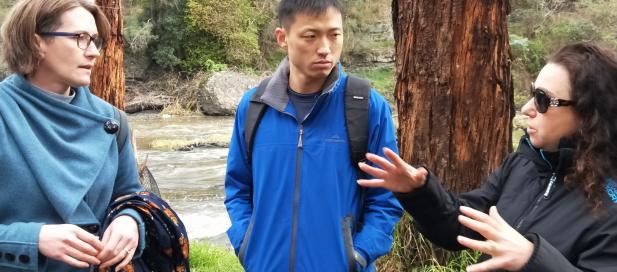
The Office of the Commissioner for Environmental Sustainability (OCES) team enjoyed a sunny, wintry field trip up the Yarra River – ahead of the release of the State of the Yarra and its Parklands report in late 2018. As part of the day, they were treated to insights from Melbourne Water’s Waterwatch co-ordinator and accomplished scientist, Tiana Preston on how the Yarra River and its riparian edges influence the movement, breeding and eating habits of the platypus. The Yarra River, and its tributaries, act as a water highway for one of Australia’s most iconic species, the platypus.
Visiting the Yarra River at Warrandyte River Reserve, the OCES team heard firsthand from Tiana how pressures such as increased housing density, pest plants and seepage from septic tanks can diminish water quality and the environmental health of platypus dependent habitats.
Decisions on how to improve and manage the Yarra waterway are often based on live data collected by active citizen scientists who take part in Waterwatch, platypusSPOT, Frog Census, Waterbug Census and Birdlife Australia.
The OCES team heard how citizen science data for platypusSPOT uses eDNA technology to analyse the presence or absence of any platypus, at any location along the Yarra River, at any given time. environmental DNA (eDNA) technology detects a platypus specific marker gene that can be extracted from the water collected by the citizen scientist. This water can be collected by the citizen scientist at any time or location along the Yarra River or one of its tributaries.
eDNA data is verified by a scientist in a laboratory with the results provided back to both the citizen scientist and the management agency, in this case Melbourne Water. Results over time and location can help agencies such as Melbourne Water better understand how the platypus is using the Yarra River and its tributaries and importantly, inform how to better manage this water course to protect and enhance the platypus population.
Maintaining a healthy platypus highway is a great, real life example of the positive impact citizen scientists, providing frequent, real-time data for local management decisions are making every day in Victoria to help protect our natural environment.
Tiana told the Commissioner that in Victoria, while citizen scientists collect rich data over a long period through programs such as WaterWatch and that data actively informs local action, Victoria lacks a state-wide approach for consolidating verified citizen science data so that it can be used more often to inform environmental policy, decision making and planning at the State level. Developing our ability to harness citizen science and fully utilise this valuable resource at the State level, is a challenge that will gain increasing focus by government as policies such as Biodiversity 2037 are implemented. Biodiversity 2037 is a landmark 20 year policy which includes the objective to increase environmental volunteering and citizen science programs in Victoria. Goal 1, Victorians Value Nature includes the objective “five million Victorians acting to protect the natural environment.” The OCES have started delivering on this objective and exploring the challenge of meaningful adoption of citizen science in State level reporting as part of our work preparing Victoria’s first, State of the Yarra and its Parklands Report due for completion later this year.
